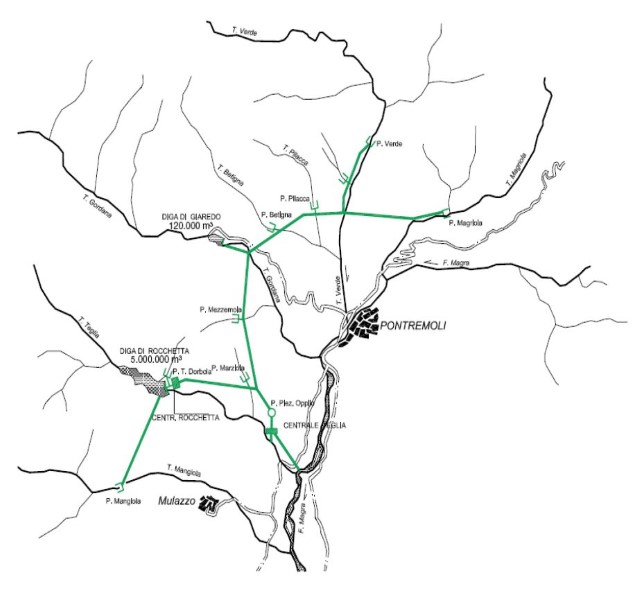
All electricity consumed in the Magra valley is obtained from renewable sources. Most comes from the Rocchetta-Teglia hydro-electric network though there is also windpower (generally confined to the Western edge of the Magra valley) and photo-voltaic arrays mouted on indvidual properties.
Hydro-electric power
The hydro-electric system is operated by Edison Spa, a firm formed in 1881 in Milan to design, build and operate a DC electrical distribution system on the lines promoted by the Edison company of America. In 2012 it was taken over by EDF of France.
The Rocchetta generating station at the base of the Teglia dam was commissioned in 1940 and has a generating capacity of 3.6MW. The Teglia generating plant is located at the bottom of the valley and can generate an additional 30.5MW. It was constructed in two phases, the first (rated at 24MW) coming into operation in 1935 and the second (rated at 6.5MW) in 1953.
A full description and report on the operation of the system may be downloaded here.
How the system works
In addition to the water discharged from the Rocchetta plant, the Teglia plant uses that of the Magriola, Verde, Bettinia, Pilacca, Lanza, Gordana, Marziola and Mezzemola streams.
The main dam is the Giaredo dam, which blocks the Gordana valley and creates the daily regulation reservoir, which has a volume of 125,000 m³. The arched dam is 27.5 m high and the crown is about 40 m long. It is equipped with a surface drain, consisting of an overflowing edge with four lights 22.94 m long, to which is added a straight section, on the left bank, 9.50 m long.
There is also a bottom drain, located in the dam body, intercepted by an electrically operated flat gate. Access to the dam is via an inclined plane and a service road. The guard house is located near the upper station of the incline plane.
The intake on the Torrente Magriola (catchment area of 18.80 km²) is made up of a straight masonry traverse equipped with an electrically operated metal gravel gate. The inlet, located on the right bank, is protected by a metal grid and leads into a still tank, just under 20 m long, with a decreasing section. From here the water enters, through a weir mouth, into a pressure diversion tunnel, sectioned by a flat gate.
After 2,167 m the tunnel crosses the valley of the Torrente Verde in a siphon. The siphon consists of a penstock and a steel pipe bridge. At this point, the tunnel is joined by that from the Rio Verde.
The intake on the Torrente Verde (42.20 km² catchment basin) consists of an arched barrier, 5 m high on the riverbed and 10 m deep below it. The arch is set on the left against the rock and on the right against a stone masonry spur, in which there is a 7.50 m gravel opening equipped with an electrically operated flat gate. The intake mouth is protected with a grid and leads into a still tank, on average 13 m wide and equipped with a sandblasting gate, which gradually connects to the mouth of a channel equipped with a 27 m long spillway. Finally, a pressure tunnel follows, 2.15 m in diameter and 2,139 m long, up to the entry into the main tunnel. The maximum different flow rate is 6 m³ / s.
The waters of the Lanza, Pilacca and Bettinia rivers also enter this tunnel.
The minor intakes on the Bettigna, Pilacca, Lanza streams are very similar to each other and consist of overflowing arched crossbeams, equipped with a gravel gate, an intake protected by a grid, a still tank with spillway. From the latter, the water overflows into a collection tank and from there to an inlet well in the Rio Verde tunnel. The maximum different flow rate is, overall, 2m³/s.
At the entrance to the Rio Verde there is an overflow well in the main tunnel.
Next, the tunnel heads towards the Gordana valley, with a 3,380 m long section. The valley is crossed by a 53.50 m long reinforced concrete pipe bridge.
Downstream of the pipe bridge, the pressurized tunnel coming from the Giaredo dam enters: this has a diameter of 1.9 m and a length of 1,034 m, the maximum flow rate that can be bypassed is 11m³/s. Also in this case, at the entrance to the main tunnel there is an overflow well.
The tunnel then continues towards the Val Marziola, with a new section of 3,641 m whose diameter is 2.8 m for a derivable flow rate of 21 m³ / s. The derivation of the Rio Mezzemola enters this section, whose outlet is similar to the other minor inlets. At the entrance to the Mezzemola there is a third overflow well.
Val Marziola also reaches the pressure tunnel coming from the discharge of the Rocchetta power plant, which crosses the valley with a steel pipe bridge, 30 m long. Before flowing into the main gallery, it also collects the flow of the Rio Marziola, derived from an outlet similar to the minor ones. After the conjunction of the Val Marziola, the tunnel continues for 789 m and reaches the Oppido where the piezometric well is located. This is equipped with an expansion tank of 5,500 m³ and is followed by the penstock which extends to about 1,200 m at a diameter of 2.9 m. The first (bolted) section leads to an automatic safety butterfly valve, followed by an air return valve. Downstream of this, the pipeline splits: the two pipelines were built at different times – one is welded and the other rivetted. Next to the pipeline there is an inclined plane for the transport of materials and people.